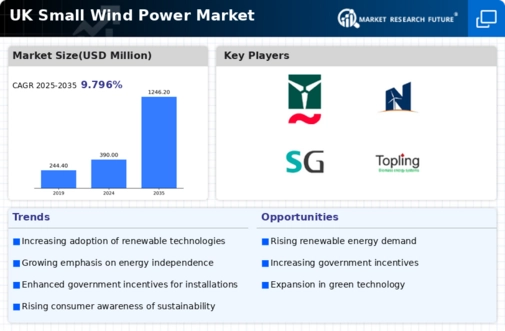The small wind-power market is currently characterized by a dynamic competitive landscape, driven by increasing demand for renewable energy solutions and a growing emphasis on sustainability. Key players such as Siemens Gamesa (ES), GE Renewable Energy (US), and Vestas Wind Systems (DK) are actively shaping the market through strategic initiatives focused on innovation and regional expansion. Siemens Gamesa, for instance, appears to be leveraging its technological expertise to enhance turbine efficiency, while GE Renewable Energy is likely concentrating on integrating digital solutions to optimize performance and maintenance. Vestas Wind Systems, on the other hand, seems to be pursuing aggressive partnerships to expand its market reach, collectively influencing the competitive environment towards a more collaborative and innovation-driven approach.
In terms of business tactics, companies are increasingly localizing manufacturing to reduce costs and enhance supply chain resilience. This trend suggests a moderately fragmented market structure, where the collective influence of key players is significant but not overwhelmingly dominant. The focus on optimizing supply chains and local production capabilities indicates a strategic shift towards greater operational efficiency, which is essential in a market that is becoming more competitive.
In October 2025, Siemens Gamesa (ES) announced a partnership with a local UK firm to develop a new line of small wind turbines tailored for urban environments. This strategic move is likely aimed at addressing the growing demand for renewable energy solutions in densely populated areas, thereby enhancing their market position. The collaboration may also facilitate knowledge transfer and innovation, positioning Siemens Gamesa as a leader in urban wind energy solutions.
In September 2025, GE Renewable Energy (US) unveiled a new digital platform designed to enhance the monitoring and maintenance of small wind turbines. This initiative appears to be a response to the increasing need for operational efficiency and predictive maintenance in the sector. By integrating advanced analytics and AI, GE is likely positioning itself to offer superior service and reliability, which could be a critical differentiator in the competitive landscape.
In August 2025, Vestas Wind Systems (DK) launched a new initiative aimed at increasing the recyclability of turbine components. This strategic focus on sustainability not only aligns with global environmental goals but also positions Vestas as a forward-thinking player in the market. The emphasis on sustainable practices may resonate well with environmentally conscious consumers and businesses, potentially enhancing brand loyalty and market share.
As of November 2025, the competitive trends in the small wind-power market are increasingly defined by digitalization, sustainability, and the integration of AI technologies. Strategic alliances among key players are shaping the landscape, fostering innovation and collaboration. Looking ahead, it is anticipated that competitive differentiation will evolve from traditional price-based competition to a focus on technological advancements, innovation, and supply chain reliability. This shift underscores the importance of adapting to market demands and leveraging strategic partnerships to maintain a competitive edge.















Leave a Comment